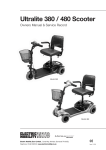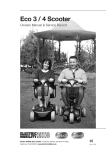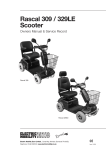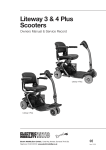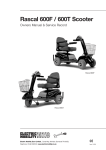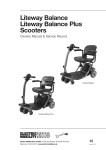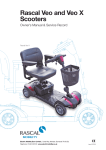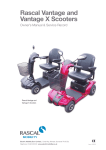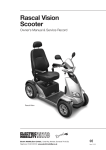Download Electric Mobility Euro Limited 650 Owner`s manual
Transcript
450 / 650 Scooter Owners Manual & Service Record Model 450 Model 650 Electric Mobility Euro Limited, Canal Way, Ilminster, Somerset TA19 9DL Telephone: 01460 258100 www.electricmobility.co.uk Issue 2: 01/08 Electric Mobility Euro Ltd has designed this powerful, durable scooter for frequent outdoor use. So long as it is maintained and operated in accordance with this manual it should last for many years, and provide you with freedom and independence. Please read this manual thoroughly before using this scooter. If you have any doubts about warnings or instructions, ask your dealer for an explanation. If you think the scooter may be damaged, do not drive it but contact your dealer for advice. We suggest that you keep this manual in a safe place. It contains essential information on the operation of the scooter and includes the maintenance records. Notice All Electric Mobility Vehicles are sold through authorised dealers. Make sure your dealer demonstrates all the features of the product prior to, or when, it is delivered. Warning! This manual contains important safety notices. Please take time to read and understand them. Ignoring them may endanger you or others. 2 2 450 & 650 Scooter Owner’s Manual & Service Record Contents Dealer information 4 Features and layout 4 Safety information 5 Intended use 5 Safety Information 6 Controls - Dashboard 7 Controls - Driving description 7 Freewheel Device 8 Brakes 9 Seat and armrest adjustment 9 Handlebar adjustment 10 Swivel seat 10 Tiller adjustment 10 Driving the vehicle 11 Driving the vehicle - hazards 12 Transporting your scooter 13 Battery charging 14 User maintenance 15 Troubleshooting guide 16 Additional safety information 16 Frequently asked questions 17 Servicing & maintenance 18 Engineers checklist 18 Guarantee & Warranty 19 Technical information regarding EMI 19 Technical specification 20 Brochure request 21 Warrantee Card - dealer information 21 Service log 23 3 Dealer Information This is your contact number for service and support Dealer Stamp Product Model Number Serial Number Date of Purchase Telephone: Email: Owner For product information see serial number plate on rear anti-tipping device bar. Manufacturer Electric Mobility Euro Limited Canal Way, Ilminster, Somerset TA19 9DL Company Registration in England No. 2419231 Features and Layout Photo shows 650 model. Features are similar for the 450 model scooter. Charging Point Forward/reverse lever Fold down backrest Fold up / Adjustable armrests Seat suspension Battery cover Removable front basket Tiller Adjustment Front suspension Pneumatic tyres all round Freewheel lever (left hand side) 4 450 & 650 Scooter Owner’s Manual & Service Record Safety Information Read this manual thoroughly before driving or operating the vehicle. This handbook is applicable for all 450 & 650 Models. If you have any doubt about the content of this manual phone your dealer to resolve the problem. Please read this manual, and ensure your scooter is serviced regularly. Within this manual there are important safety notices. They are clearly marked with the sign (left) Make sure that you understand all these notices. If you have any doubt, phone your dealer. © 2006 Electric Mobility Euro Ltd. No liability is assumed with respect to the use of any information contained in this publication. While every precaution has been taken in the preparation of this publication Electric Mobility Euro Ltd assumes no responsibility for errors of omissions nor is any liability assumed for damages resulting from the use of information contained in this publication. This publication, as well as the operational details described herein, is subject to change without notice. Intended use of the vehicle This vehicle is designed for use by adults with a disability (up to the maximum recommended weight) who require a robust comfortable pavement scooter that is ideal for shopping and other visits. The scooter is intended for use in shopping areas and trips on reasonably paved areas. It is also capable of manoeuvring on uneven surfaces and on grassy areas unless they are slippery. It has been designed to mount kerbs and small obstacles as defined in the Technical Specification pages of this manual. By law the 450 model is limited to 4 m.p.h. and is not suitable for road use. The 650 model is capable of 6 m.p.h. and is designed for occasional road use. The 650 model should be driven at no more than 4 m.p.h. when not on the road. Users could endanger themselves and others if they are not capable of driving this scooter safely. Dealers will advise on the most suitable vehicle from the Rascal range, but it is up to users to ensure that they have the manual dexterity to drive the vehicle, adequate sight and hearing to perceive danger in time, and can at all times operate the scooter safely in the expected conditions. If in doubt we suggest you consult a healthcare professional or your nearest dealer for advice on the most suitable scooter for your particular condition. Users should regularly assess their ability to operate their vehicle safely. 5 Safety Information General Warnings Warning ! The operation of scooters can endanger the life of the driver or third parties. Any driver should always be fully capable of operating this vehicle safely. Warning ! Sitting for long periods may increase the chance of thromboses or pressure sores. Users prone to such conditions are advised to take medical advice. Warning ! The 450 & 650 model scooters have been designed and tested for drivers up to 21 stone or 300 lbs or 136kgs. This weight should never be exceeded. Warning ! Front Basket. The basket mounted on the front has a weight limit of 10 lbs or 5 kgs. Do not exceed this as it could affect steering. Do not carry or attach anything to the handlebars or controls as this could affect the driving safety. Warning ! Passengers, even children, should never be carried. Warning ! Electromagnetic interference may affect the driving of this scooter: • Do not operate devices such as CB radios or mobile phones while the vehicle is switched on. • Avoid getting close to transmitter masts, such as television and radio stations. If your vehicle ever starts to operate by itself switch it off and report this to your Dealer. Warning ! The operation of scooters may affect sensitive electronic circuits such as alarm systems in shops. Driving Warning ! Freewheel device Before getting on the scooter, always check that the freewheel lever is in the "Drive” Position. When the lever is in the Freewheel position there is no braking and the scooter could run down a slope and cause injury or even death. NEVER SIT ON THE SCOOTER WHEN IN FREEWHEEL. Warning ! Damage Before driving off check the scooter for damage, particularly that which might affect the steering. Warning ! Battery Charge Before driving off always check the battery indicator. If you are in any doubt, ensure the battery is fully charged before starting on a journey. Warning ! Slopes On steep slopes the scooter could topple over. Never drive or turn across a slope. Always tackle obstacles, such as kerbs, straight on. Warning ! Speed Turning at maximum speed might cause the scooter to topple over. Always slow down for turns. On the 650 model, never select Hi speed ( 6 mph) unless you intend to travel on a road. Beware that, in Hi setting, the risk or toppling when turning is increased. Warning ! If the vehicle is left out in the sun, surfaces could become extremely hot. Always try to park the vehicle in the shade. 6 450 & 650 Scooter Owner’s Manual & Service Record Controls - Dashboard Before driving your vehicle it is important to familiarise yourself with the controls. Do not attempt to drive the vehicle before reading the rest of this Handbook. Hazard Warning & Charging Socket 2 1 3 9 4 8 5 7 6 Dashboard Description 1. Indicators: On the top left hand side of the dashboard there is a left and right indicator switch. 2. Battery Indicator: This instrument shows the level of charge in the batteries. When in the green area the batteries are fully charged. When in the yellow area the batteries need recharging and when in the red area the batteries urgently need recharging. Note: When the vehicle is climbing a steep incline or starting off, the level may drop momentarily; this is normal. 3. Speed Selection: A speed selector ( Hi Lo ) switch is fitted to the 650 model. When Hi is selected the maximum speed is 6 m.p.h. with Lo selected the maximum speed is limited to 4 m.p.h. The lower speed should always be selected for pavement use. 4. Ignition Switch: The ignition key switches power to the vehicle. Remember to remove key when not in use. Do not leave the ignition or lights on when not in use, especially when charging the vehicle. 5. Lights: When the ignition key switch is on, the head and tail lights can be switched on using the press button on the bottom right hand of the dashboard. 6. Speed Control Dial: This controls the top speed of your scooter. It is located on the dashboard below the battery indicator. When the dial is turned anticlockwise to the left, this is its slowest speed. As the dial is turned to the right the speed will increase to a maximum, which is the highest speed. Set the speed before you move off. Do not adjust when the vehicle is moving. 7. Horn: Press the button on the bottom left hand side and the horn will sound. Release and the horn will cease. 8. Hazard Warning Switch: On the left hand side of the tiller dashboard assembly is a triangular switch for selecting the hazard warning lights (650 model only). 9. Charging Point: The charging point is situated on the upper left had side of the tiller dashboard assembly (also see charging Battery Charging section for further instructions). 7 Controls - Driving Controls/Accelerator Finger control To operate, turn on the ignition. Pull the right hand lever towards you and the machine moves forward. The more you pull the lever the faster the scooter goes. To brake, release the lever. Finger control - lever Finger control - lever Again the faster the lever is released the quicker you will stop. To reverse, pull the left lever towards you. Do not pull both levers at once. The controls can be changed for customers with a left hand bias. Please contact your local dealer. Freewheel Device When the vehicle is switched off the brakes are automatically engaged. This is called “Failsafe Braking”. Also, if the batteries are flat, the brakes are applied. There may be occasions where you may wish to move the vehicle without power. To do this there is a Freewheel Device fitted. The Freewheel device allows the vehicle to be pushed without power. To activate, first locate the lever. It is located on the left hand side of the rear of the vehicle when standing behind it. (yellow lever) • • • • Make sure the ignition is switched off. Move the lever up. The vehicle can now be pushed in Freewheel. Move the lever down to engage. The vehicle is now braked - this is the normal operating position. IF YOU ARE NOT COMPLETELY SURE OF THIS FEATURE CONTACT YOUR DEALER BEFORE OPERATING THE SCOOTER. Pull the lever up to enable the vehicle to be moved without power. Braking is disabled. NEVER sit on the vehicle with the lever in this position. Push the lever down to the lower position. This is the normal operating position. The brakes are enabled, and the vehicle can only operate with the lever in this position 8 450 & 650 Scooter Owner’s Manual & Service Record Brakes There are two braking systems. The first works with the accelerator. When the accelerator is released the scooter will automatically brake and bring the scooter to a stop. When the scooter stops the automatic brake will engage. This will stop the vehicle rolling forward or backward. When you start, the brake will automatically disengage. If the battery should go flat the brakes automatically engage. Note that even when freewheel is selected, a secondary braking system is applied automatically to limit the maximum speed. You may notice this system when moving the scooter in freewheel. Warning! If the freewheel device is in “freewheel” the braking is disabled. Never select the freewheel device if the scooter is on a slope or could be pushed onto a slope. Seat Adjustment By operating the lever on the left hand side at the base of the seat back, the seat back folds down. Be careful, as the spring is quite strong, so hold the back and ease it down into the horizontal position rather than letting it go. Lifting the front lever below the seat enables it to be moved forwards and backwards. Adjust for a comfortable driving position and ensure it is locked before driving off. Armrest Adjustment When getting seated on the scooter lift the armrest up. When riding always have the armrest in the down position. If you require more room in the width of the seat undo the black knobs as shown. Slide the armrests in or out to suit. Tighten both knobs to clamp. (One on each armrest) Lift armrests up for access adjustment knobs To ensure that the user is sitting centrally, the armrests should always be adjusted to be equidistant from the centre of the seat. Warning! Always check the knobs are tight before driving the scooter. 9 Handlebar Adjustment The Handlebar adjustment allows the handlebar/dashboard assembly to be rotated to provide added clearance for getting onto and out of the scooter. Grasp the handlebars with both hands and lift. The whole assembly will raise as shown. Swivel seat This option allows easy access 1. Raise the tiller head to allow the seat to rotate fully. 2. To operate, locate the red release lever under the seat. 3. Pull the lever up and the seat will release allowing it to rotate. 4. Release the lever and the seat will lock automatically. Warning! Do not use this device if the vehicle is on a slope. Always check the seat is locked in the forward position before driving the vehicle. Tiller Adjustment The tiller adjustment allows you to alter the angle of the tiller to suit your driving style or to fold the tiller down for transporting. Locate the red lever at the base of the tiller. With one hand hold the tiller while pressing the locking lever towards the barrel. Warning! The tiller is now free to move. Move the tiller to the desired position and return the lever to the locked position while ensuring the lock pin is fully engaged in the hole. Before driving, always check that the tiller is locked. 10 450 & 650 Scooter Owner’s Manual & Service Record Driving the Vehicle Warning! Read this before driving the vehicle! Whether or not this is your first mobility vehicle, please read these guidelines as all vehicles differ. Failure to do this may cause damage to yourself, a third party or the vehicle. 1. Before you set out, do check the weather forecast. We suggest that you make sure you are wearing suitable clothing, whether your journey is long or short. 2. If you are taking medication check with your doctor or physician that your ability to control the vehicle will not be impaired and do not drink alcohol and drive. 3. Only use the vehicle for the purpose its intended for. Do not drive through deep water; transport more than one person; tow other vehicles or carry excess weight. 4. Before getting onto your scooter, check the freewheel lever is not in the Freewheel position. 5. Check the battery charger is disconnected. 6. Check you have adjusted the seat as instructed in this manual - get comfortable - set the speed control dial to a low setting. 7. Make sure the way ahead is clear. 8. Switch on the vehicle. Check the battery level indicator is in the green area. 9. Pull in right hand lever slowly. The vehicle will now move off. The more you pull the lever in the faster the vehicle will go. 10. To brake, release the lever. If you become unsure or feel unsafe release the lever immediately. 11. As you get accustomed to the power you can increase the speed. 12. On the 650 model, fitted with the Hi/Lo speed setting, only select the Hi setting when you are confident of driving safely. The hi setting is only intended to be used to drive on the road; it should not to be used when you are driving on the pavement. 11 Driving the vehicle - hazards Warning! Before driving the scooter you should be aware that, under certain circumstances it could become unstable and tip over. The maximum safe slope it can negotiate in any direction is shown in the Technical Specification. Your scooter has been designed to operate on paved, even surfaces and should not be used on rough terrain. 1. Getting on and off the vehicle: When getting on make sure that the vehicle is on level ground, and not in freewheel mode. Ensure that the armrests are secure. When getting off, park on level ground, turn off the ignition and remove the key before leaving your seat. Make sure you get off the vehicle in a safe area. 2. Handlebar Position: Before driving, the handlebars should always be lowered into the driving position. This correctly positions the headlight and ensures all the controls are in the right position for comfortable operation. 3. Tiller Position: Never drive with the tiller in the unlocked position, as injury could result from unintended tiller movement while driving. 4. Curbs and Obstacles: Do not ride up kerbs or obstructions higher than that in the Technical Specification Sheets. Always tackle curbs and obstacles head on. The sprung anti-tip rollers at the rear of the scooter may contact the kerb as you descend; this may cause a loud click. This is normal. Always try to avoid crossing a slope. If you have to cross a slope, take great care to avoid tipping. Never make sharp turns on slopes. 5. Hills & Slopes: Going Up Hill: Lean forward when going up. Make sure you have enough speed to climb the slope. Do not stop or turn the vehicle around. If you have to turn while climbing an incline, keep going until you reach a level area. If you have to start on an incline, lean forward and apply power slowly - do not start and stop. If you are not comfortable with the hill gradient, consider adjusting your seat position forward to go uphill. Alternatively consider an alternative route. Note: Always check that the battery level is high; going up hill takes a lot of energy. If the level drops too low the vehicle will automatically cut-out. 6. Hills & Slopes: Going Down Hill: Lean back in the seat when going down, and turn the speed control dial to low. If you are not comfortable with the hill gradient, consider adjusting your seat position further back when going downhill. Alternatively consider an alternative route. Try to avoid crossing slopes – always try to drive straight up and down the slope NEVER BACK DOWN A SLOPE! 7. Turning: Slow down and look in the direction you are travelling - If there is a blind corner sound the horn. 8. Bad Weather: If it is snowing or icy stay at home! Remember that ice, snow and slippery surfaces such as manhole covers, wet grass and drains could affect braking and steering. Use caution at all times. 9. Pneumatic Tyres: Your vehicle is fitted with pneumatic tyres to give you a smooth comfortable ride over uneven ground. Repair of tyres or wheels should be by your local dealer. If you are particularly concerned about punctures consult you local dealer for advice on puncture proofing products. 12 450 & 650 Scooter Owner’s Manual & Service Record Transporting your Scooter Warning! Dismantling the scooter involves lifting and handling heavy parts. Weights are given in the Technical Specification; consider if you need help in handling parts before you try to lift them. The 450 and 650 models can be transported in estate cars using ramps. By lowering the tiller and removing the seat the height can be reduced to make entry into the boot of most estate cars possible. Contact your dealer for advice on how best to transport you scooter. Warning! Pinching or Crushing. Be careful to avoid being pinched or having your hands crushed when lifting or handling parts. Wear gloves whenever possible. To transport your scooter you may need to dismantle it. Follow these instructions 1. 2. 3. 4. 5. 6. 7. Lift the red lever to unlock seat (picture 1) and lift the seat vertically away from the chassis. Warning: The seat is heavy and you may require help to lift it clear. Raise tiller dashboard until it is in the uppermost postion. Rotate the tiller by operating the tiller lever until the lock is disengaged. Lower tiller to the horizontal postion as shown (picture 2) Using ramps drive the scooter up ramps into the boot of the estate car. Secure scooter so it cannot move when the car is in motion or stops suddenly. Stow seat - you may require help to lift the seat. 1 2 Warning! This vehicle is not suitable for use as a seat for an occupant when in a motor vehicle. 13 Battery Charging Warning! When charging batteries NEVER smoke. Do not charge batteries in a place where there are naked flames such as gas-fired heaters as, under exceptional circumstances, batteries may give off gases which could ignite and explode. Warning! When charging batteries NEVER connect or disconnect the charger while it is still connected to the mains. Tiller Head Battery Charger The charging socket is located in the side of the tiller head (see picture). Slide round the protective cover and push in the round silver plug. When the vehicle is charged remove the plug and check the protective cover is set in the closed position. This keeps water out. The battery charger (see picture) has a small lamp as shown. When the charger is connected and switched on it will show red . When the battery is charged the lamp will change to green. Correct battery charging prolongs the life of your batteries. Connection Instructions When you receive your vehicle the batteries are only partially charged - always fully charge them before use preferably over-night. 1. 2. 3. 4. 5. 6. 7. Place your machine in an area that is dry and well ventilated. Make sure a power point is nearby. Check the vehicle is switched off and the key removed. Check the mains switch is off. Never connect or disconnect the charger with the mains on. Connect the charger to the battery as above. Connect the mains plug and switch on the charger. The power illuminates red when switched on. The charger lamp changes to green when fully charged. Switch off the mains and remove the plug from the battery when fully charged. Do not leave the charger plugged in with the power off. This will gradually discharge your battery. The batteries are the lifeblood of your vehicle. Their characteristics can change depending on charging, temperature, usage and other factors. 14 450 & 650 Scooter Owner’s Manual & Service Record Battery Charging (con’t) Listed below are guidelines to prolong battery life. 1. 2. 3. 4. 5. 6. 7. After using your vehicle always charge it at the end of the day even after a short journey. If you do not use your vehicle for a prolonged period, place it on charge once a week, overnight. Always use the correct charger with the correct batteries. If the batteries have been flat for a long time (about 2 months) it is recommended you contact your dealer before charging: Do not charge the vehicle in the open - it may rain and the battery charger is not waterproof. Keep the vehicle in a well-ventilated area and away from any naked flame. Do not part charge the batteries. Allow the charger to complete its cycle. Warning! If one or both batteries are damaged they could heat up when charging and, in an extreme case, explode. Only replace the batteries with the same capacity gel batteries on the advice of your local dealer. These items are expensive to replace - it is wise to look after them. Notice Return your unserviceable batteries to your supplier or ensure they are disposed of in accordance with the environmental regulations applicable at the time. User Maintenance It is important for safety that you carry out the following checks before use. 1. 2. 3. 4. 5. 6. 7. 8. 9. Visually check the machine for damage. Visually check the tyres for damage and check if they need inflating. (See page 21 for recommended pressures) Check the steering moves freely. Check that the Tiller lock is engaged. Check that the Seat is located correctly and locked. Check the armrests are secure and the knobs are tight Batteries should be fully charged. Ensure the front basket is secure. Keep your vehicle clean by washing with a sponge and soapy water - never use a hose. Important - Possible faults As you get used to your vehicle you will get a feel for how it behaves. If something feels unusual, for instance the vehicle does not accelerate or brake smoothly; the brakes are not holding on a slope or the steering feels different, contact your dealer immediately and explain to the engineer exactly what the problem is. Disposal Contact your dealer for advice before you consider disposing of your scooter. They will be aware of the environmental regulations applicable at the time and will assist you to meet the applicable environmental legislation. 15 Troubleshooting Guide This table is a guide to fault finding. The fault may be a simple fix. If you have any doubts phone your dealer. Symptom Solution • Scooter does not move. when power is switched on. • Batteries flat - check level. • Is the charger connected? • Freewheel is engaged. • Steering is loose or wobbly when driven. • • • • • Vehicle behaves erratically when driven. judders or cuts out ? • Possible electronic problems - contact dealer. • Short Range • Check tyre pressure. • Check battery level. Check tyre pressure. Check for tyre damage or punctures. Damaged steering - contact dealer. Loose seat - contact dealer. Your dealer is there to help you but they can only do this if you give them as much information as possible. Remember correct information will get the problem fixed quicker and save you money. Phone the dealer and explain exactly what the problem is. Remember small points help the engineer to identify the problem before he calls to fix it. Additional Safety Information Carrying Weight on the Vehicle Front Basket The basket mounted on the front has a weight limit of 10lbs (5kgs). Do not exceed this as it could effect the steering. Handlebars Do not carry or attach anything to the handlebars. Anything attached to the handlebars will affect the control of the vehicle. Floor Area Do not use the floor area to carry things. They might fall off, or obstruct your movement. Modifications Unauthorised modifications could result in injury or permanent damage. Such modifications will invalidate your warranty. Other Items Only fit approved products or accessories. Child Safety This product is designed to be operated by adults with a disability. Children should not be allowed to tamper with the controls or play on the vehicle. Do not carry children as passengers. The product is designed for single person use only. Keep all packaging well away from children. They could be harmed. 16 450 & 650 Scooter Owner’s Manual & Service Record Frequently Asked Questions I want to transport my vehicle in a car. See page 13 - Transporting your scooter. We suggest transporting your vehicle in an estate car using ramps. There are various techniques to loading the vehicle into a car. It depends on what type of vehicle you own. Make sure your dealer has demonstrated the easiest way of doing this. Can I fit weatherproofing such as a canopy ? Yes, but remember if you fit any unauthorised accessories, it will invalidate your warranty. Be aware that enclosed canopies can affect the handling of the vehicle in strong winds. How long will my batteries last ? This is a difficult question as it depends on many factors. The life of a battery depends upon the number of cycles the battery goes through, the peak loads and on the conditions of use. Some general advice about battery care: • Keep them charged, do not let the batteries run completely flat. • Batteries may not perform as well in very cold weather. • Change your batteries if you find they are not performing as well as new. What range can I expect ? The generally expected range is about 40 Km or 25 miles. However, range can be affected by many things such as: • Temperature. Cold weather can reduce the output of the batteries. • Type of terrain. Obviously climbing hills takes more energy than driving on the flat. • Weight of the user. • The condition and charge of the batteries. • Faulty or old batteries • Faulty charger Important Rule: Always use the correct charger with the correct batteries. How long should I keep my vehicle before I change it? It is important that the vehicle you have suits your needs and abilities. Your 450 & 650 model scooter should serve you well for many years but change it if at any time you feel it no longer meets your needs. Consult your dealer on the condition of your vehicle and remember vehicles of any type become more expensive to maintain the older they get. Additional Information Owners Manual: Replacement copies are available from: Electric Mobility Euro Ltd. Canal Way, Ilminster, Somerset, TA19 9DL Telephone: 01460 258100 Each vehicle comes with a copy of the BHTA Highway Code. Please make sure you read it. Telephone BHTA on 02077 022 141 for a new copy. Important note on the BHTA Highway Code: On page 3 of the Code under “Consider Investing in a mobile phone” Read the section of this manual under “Safety Information”. If in doubt contact your dealer. For Information regarding other Electric Mobility products contact your dealer or log on to the Electric Mobility Website www.electricmobility.co.uk 17 Servicing and Maintenance 1. This vehicle is designed for minimum maintenance. However it is recommended that your vehicle is serviced at least once a year, by an approved Electric Mobility Dealer. If the vehicle is used constantly we recommend a twice-yearly maintenance. 2. Ensure the engineer stamps the Service Log (page 23) on completion for all servicing carried out on this vehicle. Keep all receipts for servicing and repairs with this handbook. This may add value when selling the vehicle. 3. When the vehicle is due for its annual service make sure you report any concerns you have, preferably when you book the service (See points to look out for below). 4. On completion of the service, Always test the vehicle before the engineer leaves and make sure you are satisfied with the work carried out. 5. Replacement: the engineer can advise you when the scooter needs replacing. Points to look out for: • Are there any strange noises from the wheels or does the frame creak when going over rough ground? • Are the batteries charging up correctly - is the full charge light coming on after charging? • Is the steering tight or is it loose when turning? Is there any play in the steering? • Has anything come loose? • Does the vehicle perform as well as it did when it was new? • Are there noises or rattles that were not there before? • Are there any signs of damage or cracking? Engineer’s Checklist for 450 and 650 Models • Initial diagnostic road test • Handlebar alignment • Wheel bearings wear and lubricate • Motor brush wear • Wheel alignment and tracking • Motor speed check • Speed dial works correctly • Electromagnetic brake operation • For 650 model Hi/Low speed selection works correctly • Freewheel operation • Wear or damage to tyres or wheels • Frame for damage or cracks • Bodywork fixtures • General corrosion • Throttle play and adjustment • All operational controls work correctly • Battery box contacts & signs of corrosion • Battery condition and charger operation • Steering bearing (adjust as required) • Tighten all nuts & bolts • Tiller adjustment - functioning , wear and damage • Final road test • Seat mounting • Clean vehicle • Revolving seat mechanism locates correctly • Customer road test Important Note for the Engineer Enquire if the customer is satisfied with the product. Please report all points good or bad directly to: Electric Mobility +(0)1460 258100 If you have any comments please include them. 18 450 & 650 Scooter Owner’s Manual & Service Record Guarantee and Warranty Lifetime Frame Guarantee Electric Mobility Euro Ltd guarantees the frame of its vehicles to be free from defect in materials and workmanship under normal use as described in this document for the lifetime of the vehicle. Should a defect in materials or workmanship appear, Electric Mobility Euro Ltd, will repair, or at its option, replace the frame to the original owner. One Year Limited Warranty Electric Mobility Euro Ltd warrants its products against defects in material and workmanship for a period of one year, providing the products are properly assembled, operated and maintained in accordance with the vehicle Owners Manual. This limited warranty commences on the date of the original retail purchase or original use, whichever occurs first, providing the warranty card is fully and correctly filled out and returned to Electric Mobility Euro Ltd Customer Service Department within 15 days from receipt of product. If a defective part appears within the stated limited warranty period and the purchaser has given Electric Mobility Euro Limited immediate notice the Company will repair the part or at its option replace the part with a similar part. No allowance will be made for repairs to any equipment without the expressed written or verbal approval of Electric Mobility Euro Limited. Any description, specifications, samples, models, bulletins or similar materials used in connection with the sales of Electric Mobility Euro Limited products are for the sole purpose of identifying the equipment and are not to be construed as expressed warranties. Electric Mobility Euro Ltd shall not be liable for special, indirect or consequential damage. Electric Mobility Euro Ltd’s liability on any claim of any kind including negligence for any loss or damage arising out of, connected to, or resulting from the order of the performance thereof the design, manufacture, sale, delivery, resale, direction and instructions, inspection, repair or use of any equipment covered by or furnished by, under this order, shall in no case exceed the price paid by the purchaser for the equipment. This limited warranty does not cover normal maintenance service, or periodic adjustments necessitated by use of wear. Under no circumstances will charges for labour, consequential damage or repair expense be allowed after 30 days from receipt of product. Technical Information Regarding EMI Important Technical Information regarding Electromagnetic Interference (EMI) The intensity of interference from electromagnetic energy is measured in volts per meter (v/m), which refers to the strength of the electrical source (voltage) as it relates to the distance away from the object being considered (in meters). Resistance of a scooter/wheelchair to certain EMI intensity is commonly called its “immunity level”. 20 volts/meter is a generally achievable and useful immunity level against interference from radio wave sources (the higher the immunity level, the greater protection). Your scooter has been tested and found to meet the required immunity level from Electromagnetic Interference (20v/m): the recommended density of interference from electromagnetic energy. Warning! Even with the immunity level of 20 volts/meter, certain precautions must be followed to ensure your scooter/wheelchair will not be affected by outside electromagnetic sources. • Do not operate devices such as CB radios or mobile phones while the vehicle is switched on. • Avoid getting close to transmitter masts, such as television and radio masts. • Note you may experience interference when close to ambulance or fire stations. If your vehicle starts to operate by itself switch it off and report this to your Dealer. 19 Technical Specification - 450 Model 4 Wheeler Wheelchair type class Department of Transport class Overall dimensions fully assembled Dimensions seat removed tiller folded Maximum carry capacity Mass (weight) including batteries Battery voltage and capacity Mass (weight) of battery pack Type of seat Mass (weight) of seat Mass (weight) of front section Mass of (weight) of rear section Wheel size Type of tyres Tyre pressures normal Tyre pressure maximum - not to be exceeded Maximum speed Minimum braking distance from maximum speed Range on full charge and flat ground The turn-around width The maximum safe slope The maximum climbing ability facing upwards Ground clearance Maximum obstacle climbing ability Maximum safe descendable kerb height Class A, B or C Class 1 2 or 3 length x width x height mm (in) length x width x height mm (in) kg (lb) kg (lb) volts and ampere hours kg (lb) kg (lb) kg (lb) kg (lb) front/rear mm (in) Type front/rear p.s.i. (bar) front/rear p.s.i. (bar) km/h (m.p.h.) m (yds) km (miles) m (ft) Degrees Degrees mm (in) mm (in) mm (in) Class C for most terrains Class 2 for most terrains 1280 (50) x 630 (25) x 1250 (49) 1280 (50) x 630 (25) x 590 (23) 136 (300) 95 (209) 12 V 50 Ah qty 2 Each battery weighs 16 kg (35lb) Swivel seat with adjustable width & height 9.4 (20.07) Front & rear permanently attached Front & rear permanently attached All wheels 254 x76 (10 x 3) Pneumatic tyres 30-35 p.s.i. (2 bar) 50 p.s.i (3.5 bar) 6.4 (4) 1.4 (1.5) 40 (25) 3.04m (10ft 1.5”) 8˚ - Do not exceed the scooter may topple 9˚ with 90kg (200lb) driver 60 (2.3) 60 (2.3) 60 (2.3) Technical Specification - 650 Model 4 Wheeler Wheelchair type class and Department of Transport class Overall dimensions fully assembled Dimensions seat removed tiller folded Maximum carry capacity Mass (weight) including batteries Battery voltage and capacity Mass (weight) of battery pack Type of seat Mass (weight) of seat Mass (weight) of front section Mass of (weight) of rear section Wheel size Type of tyres Tyre pressures normal Tyre pressure maximum - not to be exceeded Maximum speed Minimum braking distance from maximum speed Range on full charge and flat ground The turn-around width The maximum safe slope The maximum climbing ability facing upwards Ground clearance Maximum obstacle climbing ability Maximum safe descendable kerb height Class A,B or C Class 1 2 or 3 length x width x height mm (in) length x width x height mm (in) kg (lb) kg (lb) volts and ampere hours kg (lb) kg (lb) kg (lb) kg (lb) front/rear mm (in) type front/rear p.s.i. (bar) front/rear p.s.i. (bar) In km/h (m.p.h.) m (yds) km (miles) m (ft) Degrees Degrees mm (in) mm (in) mm (in) Class C for most terrains Class 3 for most terrains 1280 (50) x 630 (25) x 1250 (49) 1280 (50) x 630 (25) x 620 (24.5) 136 (300) 105 (231) 12 V 50 Ah qty 2 Each battery weighs 16kg (35lb) Swivel seat with adjustable width & height 9.4 (20.07) Front & rear permanently attached Front & rear permanently attached All wheels 290 x 70 (11 x 2.75) Pneumatic tyres 30-35 p.s.i. (2 bar) 50 p.s.i (3.5 bar) 9.7 (6) 2.3 (2.5) 38 (24) 3.04m (10ft 1.5”) 8˚ – do not exceed the scooter may topple 9˚ with 90kg (200lb) driver 100 (4) 100 (4) 100 (4) Due to a policy of continual improvement Electric Mobility Euro Ltd. reserves the right to change the specification without prior notice. 20 450 & 650 Scooter Owner’s Manual & Service Record Brochure Request Do you have a friend or colleague that would be interested in an Electric Mobility product? If so cut out this coupon and send it to the address shown on the back of the manual. My Dealer’s Company name is: Please can I have a free no-obligation home demonstration. Please send me a brochure of the range of products. My friend’s name is: My friend’s address is: County: Postcode: My friend’s telephone number is: If you are visually impaired, please contact the Company to discuss your requirements. However, you should not drive a vehicle in a public place if you cannot see well enough to ensure your own, and others safety. Postage will be paid by: Electric Mobility Euro Ltd., FREEPOST (SWBI 1045), Ilminster, Somerset, TA19 9ZA Dealer Information - Warranty Card This section is to be filled out by the Dealer and sent to Electric Mobility Euro Ltd. Dealer: Product Description: Serial No.: Invoice No.: Customer Name & Address: County: Postcode: Telephone No.: Date received at Dealers: # Postage will be paid by: Electric Mobility Euro Ltd., FREEPOST (SWBI 1045), Ilminster, Somerset, TA19 9ZA 21 # Electric Mobility Euro Ltd., FREEPOST (SWBI 1045), Ilminster, Somerset, TA19 9ZA Electric Mobility Euro Ltd., FREEPOST (SWBI 1045), Ilminster, Somerset, TA19 9ZA Service Log Notice for the Service Engineer. Please make sure this part is stamped and dated after each service. Dealer stamp - 1st Service Dealer stamp - 2nd Service Dealer stamp - 3rd Service Dealer stamp - 4th Service Dealer stamp - 5th Service Dealer stamp - 6th Service Dealer stamp - 7th Service Dealer stamp - 8th Service 23 450 / 650 Scooter Manufactured by Electric Mobility Euro Limited, Canal Way, Ilminster, Somerset TA19 9DL P/N: 300905-27 Telephone: 01460 258100 www.electricmobility.co.uk E. and O.E. Issue 1: 07/07
























